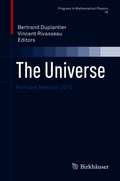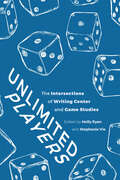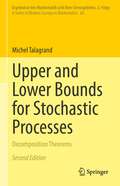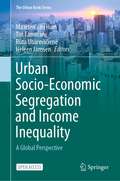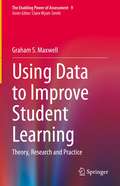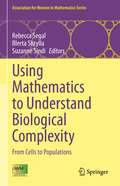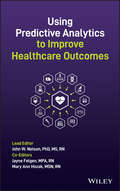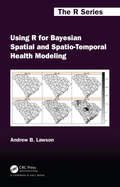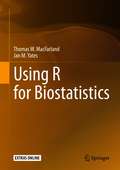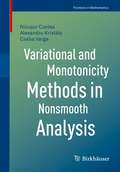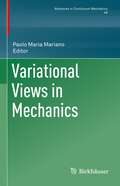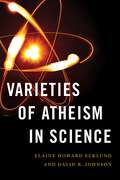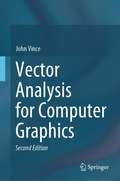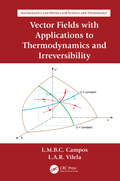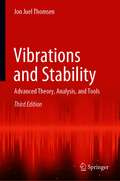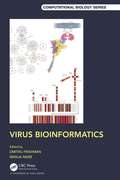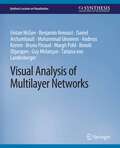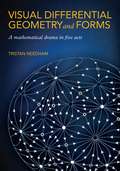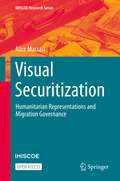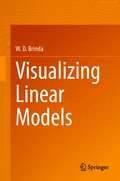- Table View
- List View
The Universe: Poincaré Seminar 2015 (Progress in Mathematical Physics #76)
This volume provides a detailed description of some of the most active areas in astrophysics from the largest scales probed by the Planck satellite to massive black holes that lie at the heart of galaxies and up to the much awaited but stunning discovery of thousands of exoplanets. It contains the following chapters: • Jean-Philippe UZAN, The Big-Bang Theory: Construction, Evolution and Status • Jean-Loup PUGET, The Planck Mission and the Cosmic Microwave Background • Reinhard GENZEL, Massive Black Holes: Evidence, Demographics and Cosmic Evolution • Arnaud CASSAN, New Worlds Ahead: The Discovery of ExoplanetsReinhard Genzel and Andrea Ghez shared the 2020 Nobel Prize in Physics “for the discovery of a supermassive compact object at the centre of our galaxy’”, alongside Roger Penrose “for the discovery that black hole formation is a robust prediction of the general theory of relativity”. The book corresponds to the twentieth Poincaré Seminar, held on November 21, 2015, at Institut Henri Poincaré in Paris. Originally written as lectures to a broad scientific audience, these four chapters are of high value and will be of general interest to astrophysicists, physicists, mathematicians and historians.
Unlimited Players: The Intersections of Writing Center and Game Studies
Unlimited Players provides writing center scholars with new approaches to engaging with multimodality in the writing center through the lenses of games, play, and digital literacies. Considering how game scholarship can productively deepen existing writing center conversations regarding the role of creativity, play, and engagement, this book helps practitioners approach a variety of practices, such as starting new writing centers, engaging tutors and writers, developing tutor education programs, developing new ways to approach multimodal and digital compositions brought to the writing center, and engaging with ongoing scholarly conversations in the field. The collection opens with theoretically driven chapters that approach writing center work through the lens of games and play. These chapters cover a range of topics, including considerations of identity, empathy, and power; productive language play during tutoring sessions; and writing center heuristics. The last section of the book includes games, written in the form of tabletop game directions, that directors can use for staff development or tutors can play with writers to help them develop their skills and practices. No other text offers a theoretical and practical approach to theorizing and using games in the writing center. Unlimited Players provides a new perspective on the long-standing challenges facing writing center scholars and offers insight into the complex questions raised in issues of multimodality, emerging technologies, tutor education, identity construction, and many more. It will be significant to writing center directors and administrators and those who teach tutor training courses.
Upper and Lower Bounds for Stochastic Processes: Decomposition Theorems (Ergebnisse der Mathematik und ihrer Grenzgebiete. 3. Folge / A Series of Modern Surveys in Mathematics #60)
by Michel TalagrandThis book provides an in-depth account of modern methods used to bound the supremum of stochastic processes. Starting from first principles, it takes the reader to the frontier of current research. This second edition has been completely rewritten, offering substantial improvements to the exposition and simplified proofs, as well as new results.The book starts with a thorough account of the generic chaining, a remarkably simple and powerful method to bound a stochastic process that should belong to every probabilist’s toolkit. The effectiveness of the scheme is demonstrated by the characterization of sample boundedness of Gaussian processes. Much of the book is devoted to exploring the wealth of ideas and results generated by thirty years of efforts to extend this result to more general classes of processes, culminating in the recent solution of several key conjectures.A large part of this unique book is devoted to the author’s influential work. While many of the results presented are rather advanced, others bear on the very foundations of probability theory. In addition to providing an invaluable reference for researchers, the book should therefore also be of interest to a wide range of readers.
Urban Socio-Economic Segregation and Income Inequality: A Global Perspective (The Urban Book Series)
by Maarten Van Ham Tiit Tammaru Rūta Ubarevičienė Heleen JanssenThis open access book investigates the link between income inequality and socio-economic residential segregation in 24 large urban regions in Africa, Asia, Australia, Europe, North America, and South America. It offers a unique global overview of segregation trends based on case studies by local author teams. The book shows important global trends in segregation, and proposes a Global Segregation Thesis.Rising inequalities lead to rising levels of socio-economic segregation almost everywhere in the world. Levels of inequality and segregation are higher in cities in lower income countries, but the growth in inequality and segregation is faster in cities in high-income countries. This is causing convergence of segregation trends. Professionalisation of the workforce is leading to changing residential patterns. High-income workers are moving to city centres or to attractive coastal areas and gated communities, while poverty is increasingly suburbanising. As a result, the urban geography of inequality changes faster and is more pronounced than changes in segregation levels. Rising levels of inequality and segregation pose huge challenges for the future social sustainability of cities, as cities are no longer places of opportunities for all.
Using Data to Improve Student Learning: Theory, Research and Practice (The Enabling Power of Assessment #9)
by Graham S. MaxwellThis book offers a coherent research-based overview and analysis of theories and practices in using data to improve student learning. It clarifies what 'use of data' means and differentiates the different levels of decision-making in education (relating to the system, district, school, classroom, or individual student). The relationship between data and decision-making is considered and various movements in the use of data to improve student learning are analysed, especially from the perspective of their assumptions and effects. This leads to a focus on effective educational decision-making as a social process requiring collaboration among all relevant participants. It also requires a clear understanding of educational aims, and these are seen to transcend what can be assessed by standardised tests. The consequences of this analysis for decision processes are explored and conclusions are drawn about what principles might best guide educational practice as well as what ambiguities remain. Throughout, the focus is on what existing research says about each of the issues explored.
Using Mathematics to Understand Biological Complexity: From Cells to Populations (Association for Women in Mathematics Series #22)
by Rebecca Segal Blerta Shtylla Suzanne SindiThis volume tackles a variety of biological and medical questions using mathematical models to understand complex system dynamics. Working in collaborative teams of six, each with a senior research mentor, researchers developed new mathematical models to address questions in a range of application areas. Topics include retinal degeneration, biopolymer dynamics, the topological structure of DNA, ensemble analysis, multidrug-resistant organisms, tumor growth modeling, and geospatial modeling of malaria. The work is the result of newly formed collaborative groups begun during the Collaborative Workshop for Woman in Mathematical Biology hosted by the Institute of Pure and Applied Mathematics at UCLA in June 2019. Previous workshops in this series have occurred at IMA, NIMBioS, and MBI.
Using Predictive Analytics to Improve Healthcare Outcomes
by John W. Nelson Jayne Felgen Mary Ann HozakUsing Predictive Analytics to Improve Healthcare Outcomes Discover a comprehensive overview, from established leaders in the field, of how to use predictive analytics and other analytic methods for healthcare quality improvement.Using Predictive Analytics to Improve Healthcare Outcomes delivers a 16-step process to use predictive analytics to improve operations in the complex industry of healthcare. The book includes numerous case studies that make use of predictive analytics and other mathematical methodologies to save money and improve patient outcomes. The book is organized as a “how-to” manual, showing how to use existing theory and tools to achieve desired positive outcomes.You will learn how your organization can use predictive analytics to identify the most impactful operational interventions before changing operations. This includes: A thorough introduction to data, caring theory, Relationship-Based Care®, the Caring Behaviors Assurance System©, and healthcare operations, including how to build a measurement model and improve organizational outcomes. An exploration of analytics in action, including comprehensive case studies on patient falls, palliative care, infection reduction, reducing rates of readmission for heart failure, and more—all resulting in action plans allowing clinicians to make changes that have been proven in advance to result in positive outcomes.Discussions of how to refine quality improvement initiatives, including the use of “comfort” as a construct to illustrate the importance of solid theory and good measurement in adequate pain management.An examination of international organizations using analytics to improve operations within cultural context.Using Predictive Analytics to Improve Healthcare Outcomes is perfect for executives, researchers, and quality improvement staff at healthcare organizations, as well as educators teaching mathematics, data science, or quality improvement. Employ this valuable resource that walks you through the steps of managing and optimizing outcomes in your clinical care operations.
Using Predictive Analytics to Improve Healthcare Outcomes
by John W. NelsonUsing Predictive Analytics to Improve Healthcare Outcomes Discover a comprehensive overview, from established leaders in the field, of how to use predictive analytics and other analytic methods for healthcare quality improvement.Using Predictive Analytics to Improve Healthcare Outcomes delivers a 16-step process to use predictive analytics to improve operations in the complex industry of healthcare. The book includes numerous case studies that make use of predictive analytics and other mathematical methodologies to save money and improve patient outcomes. The book is organized as a “how-to” manual, showing how to use existing theory and tools to achieve desired positive outcomes.You will learn how your organization can use predictive analytics to identify the most impactful operational interventions before changing operations. This includes: A thorough introduction to data, caring theory, Relationship-Based Care®, the Caring Behaviors Assurance System©, and healthcare operations, including how to build a measurement model and improve organizational outcomes. An exploration of analytics in action, including comprehensive case studies on patient falls, palliative care, infection reduction, reducing rates of readmission for heart failure, and more—all resulting in action plans allowing clinicians to make changes that have been proven in advance to result in positive outcomes.Discussions of how to refine quality improvement initiatives, including the use of “comfort” as a construct to illustrate the importance of solid theory and good measurement in adequate pain management.An examination of international organizations using analytics to improve operations within cultural context.Using Predictive Analytics to Improve Healthcare Outcomes is perfect for executives, researchers, and quality improvement staff at healthcare organizations, as well as educators teaching mathematics, data science, or quality improvement. Employ this valuable resource that walks you through the steps of managing and optimizing outcomes in your clinical care operations.
Using R for Bayesian Spatial and Spatio-Temporal Health Modeling (Chapman & Hall/CRC The R Series)
by Andrew B. LawsonProgressively more and more attention has been paid to how location affects health outcomes. The area of disease mapping focusses on these problems, and the Bayesian paradigm has a major role to play in the understanding of the complex interplay of context and individual predisposition in such studies of disease. Using R for Bayesian Spatial and Spatio-Temporal Health Modeling provides a major resource for those interested in applying Bayesian methodology in small area health data studies. Features: Review of R graphics relevant to spatial health data Overview of Bayesian methods and Bayesian hierarchical modeling as applied to spatial data Bayesian Computation and goodness-of-fit Review of basic Bayesian disease mapping models Spatio-temporal modeling with MCMC and INLA Special topics include multivariate models, survival analysis, missing data, measurement error, variable selection, individual event modeling, and infectious disease modeling Software for fitting models based on BRugs, Nimble, CARBayes and INLA Provides code relevant to fitting all examples throughout the book at a supplementary website The book fills a void in the literature and available software, providing a crucial link for students and professionals alike to engage in the analysis of spatial and spatio-temporal health data from a Bayesian perspective using R. The book emphasizes the use of MCMC via Nimble, BRugs, and CARBAyes, but also includes INLA for comparative purposes. In addition, a wide range of packages useful in the analysis of geo-referenced spatial data are employed and code is provided. It will likely become a key reference for researchers and students from biostatistics, epidemiology, public health, and environmental science.
Using R for Bayesian Spatial and Spatio-Temporal Health Modeling (Chapman & Hall/CRC The R Series)
by Andrew B. LawsonProgressively more and more attention has been paid to how location affects health outcomes. The area of disease mapping focusses on these problems, and the Bayesian paradigm has a major role to play in the understanding of the complex interplay of context and individual predisposition in such studies of disease. Using R for Bayesian Spatial and Spatio-Temporal Health Modeling provides a major resource for those interested in applying Bayesian methodology in small area health data studies. Features: Review of R graphics relevant to spatial health data Overview of Bayesian methods and Bayesian hierarchical modeling as applied to spatial data Bayesian Computation and goodness-of-fit Review of basic Bayesian disease mapping models Spatio-temporal modeling with MCMC and INLA Special topics include multivariate models, survival analysis, missing data, measurement error, variable selection, individual event modeling, and infectious disease modeling Software for fitting models based on BRugs, Nimble, CARBayes and INLA Provides code relevant to fitting all examples throughout the book at a supplementary website The book fills a void in the literature and available software, providing a crucial link for students and professionals alike to engage in the analysis of spatial and spatio-temporal health data from a Bayesian perspective using R. The book emphasizes the use of MCMC via Nimble, BRugs, and CARBAyes, but also includes INLA for comparative purposes. In addition, a wide range of packages useful in the analysis of geo-referenced spatial data are employed and code is provided. It will likely become a key reference for researchers and students from biostatistics, epidemiology, public health, and environmental science.
Using R for Biostatistics
by Thomas W. MacFarland Jan M. YatesThis book introduces the open source R software language that can be implemented in biostatistics for data organization, statistical analysis, and graphical presentation. In the years since the authors’ 2014 work Introduction to Data Analysis and Graphical Presentation in Biostatistics with R, the R user community has grown exponentially and the R language has increased in maturity and functionality. This updated volume expands upon skill-sets useful for students and practitioners in the biological sciences by describing how to work with data in an efficient manner, how to engage in meaningful statistical analyses from multiple perspectives, and how to generate high-quality graphics for professional publication of their research. A common theme for research in the diverse biological sciences is that decision-making depends on the empirical use of data. Beginning with a focus on data from a parametric perspective, the authors address topics such as Student t-Tests for independent samples and matched pairs; oneway and twoway analyses of variance; and correlation and linear regression. The authors also demonstrate the importance of a nonparametric perspective for quality assurance through chapters on the Mann-Whitney U Test, Wilcoxon Matched-Pairs Signed-Ranks test, Kruskal-Wallis H-Test for Oneway Analysis of Variance, and the Friedman Twoway Analysis of Variance. To address the element of data presentation, the book also provides an extensive review of the many graphical functions available with R. There are now perhaps more than 15,000 external packages available to the R community. The authors place special emphasis on graphics using the lattice package and the ggplot2 package, as well as less common, but equally useful, figures such as bean plots, strip charts, and violin plots. A robust package of supplementary material, as well as an introduction of the development of both R and the discipline of biostatistics, makes this ideal for novice learners as well as more experienced practitioners.
Variational and Monotonicity Methods in Nonsmooth Analysis (Frontiers in Mathematics)
by Nicuşor Costea Alexandru Kristály Csaba VargaThis book provides a modern and comprehensive presentation of a wide variety of problems arising in nonlinear analysis, game theory, engineering, mathematical physics and contact mechanics. It includes recent achievements and puts them into the context of the existing literature.The volume is organized in four parts. Part I contains fundamental mathematical results concerning convex and locally Lipschits functions. Together with the Appendices, this foundational part establishes the self-contained character of the text. As the title suggests, in the following sections, both variational and topological methods are developed based on critical and fixed point results for nonsmooth functions. The authors employ these methods to handle the exemplary problems from game theory and engineering that are investigated in Part II, respectively Part III. Part IV is devoted to applications in contact mechanics.The book will be of interest to PhD students and researchers in applied mathematics as well as specialists working in nonsmooth analysis and engineering.
Variational Views in Mechanics (Advances in Mechanics and Mathematics #46)
by Paolo Maria MarianoThis volume provides a timely survey of interactions between the calculus of variations and theoretical and applied mechanics. Chapters have been significantly expanded since preliminary versions appeared in a special issue of the Journal of Optimization Theory and Applications (184(1), 2020) on “Calculus of Variations in Mechanics and Related Fields”. The variety of topics covered offers researchers an overview of problems in mechanics that can be analyzed with variational techniques, making this a valuable reference for researchers in the field. It also presents ideas for possible future areas of research, showing how the mastery of these foundational mathematical techniques can be used for many exciting applications. Specific topics covered include:Topology optimizationIdentification of material propertiesOptimal controlPlastic flowsGradient polyconvexityObstacle problemsQuasi-monotonicity Variational Views in Mechanics will appeal to researchers in mathematics, solid-states physics, and mechanical, civil, and materials engineering.
Varieties of Atheism in Science
by David R. Johnson Elaine Howard EcklundA significant number of Americans view atheists as immoral elitists, aloof and unconcerned with the common good, and they view science and scientists as responsible. Thanks in large part to the prominence and influence of New Atheists such as Richard Dawkins, Sam Harris, Daniel Dennett, and Christopher Hitchens, New Atheism has claimed the pulpit of secularity in Western society. New Atheists have given voice to marginalized nonreligious individuals and underscored the importance of science in society. They have also advanced a derisive view of religion and forcefully argued that science and religion are intrinsically in conflict. Many in the public around the globe think that all scientists are atheists and that all atheist scientists are New Atheists, militantly against religion and religious people. But what do everyday atheist scientists actually think about religion? Drawing on a survey of 1,293 atheist scientists in the U.S. and U.K., and 81 in-depth interviews, this book explains the pathways that led to atheism among scientists, the diverse views of religion they hold, their perspectives on the limits to what science can explain, and their views of meaning and morality. The findings reveal a vast gulf between the rhetoric of New Atheism in the public sphere and the reality of atheism in science. The story of the varieties of atheism in science is consequential for both scientific and religious communities and points to tools for dialogue between these seemingly disparate groups.
Vector Analysis for Computer Graphics
by John VinceThis book is a complete introduction to vector analysis, especially within the context of computer graphics. The author shows why vectors are useful and how it is possible to develop analytical skills in manipulating vector algebra. Even though vector analysis is a relatively recent development in the history of mathematics, it has become a powerful and central tool in describing and solving a wide range of geometric problems. The book is divided into eleven chapters covering the mathematical foundations of vector algebra and its application to, among others, lines, planes, intersections, rotating vectors, and vector differentiation.
Vector Fields with Applications to Thermodynamics and Irreversibility (Mathematics and Physics for Science and Technology #10)
by Luis Manuel Braga da Costa Campos Luís António Raio VilelaVector Fields with Applications to Thermodynamics and Irreversibility is part of the series "Mathematics and Physics for Science and Technology", which combines rigorous mathematics with general physical principles to model practical engineering systems with a detailed derivation and interpretation of results. Volume V presents the mathematical theory of partial differential equations and methods of solution satisfying initial and boundary conditions, and includes applications to: acoustic, elastic, water, electromagnetic and other waves; the diffusion of heat, mass and electricity; and their interactions. This is the first book of the volume. The second book of volume V continues this book on thermodynamics, focusing on the equation of state and energy transfer processes including adiabatic, isothermal, isobaric and isochoric. These are applied to thermodynamic cycles, like the Carnot, Atkinson, Stirling and Barber-Brayton cycles, that are used in thermal devices, including refrigerators, heat pumps, and piston, jet and rocket engines. In connection with jet propulsion, adiabatic flows and normal and oblique shock waves in free space and nozzles with variable cross-section are considered. The equations of fluid mechanics are derived for compressible two-phase flow in the presence of shear and bulk viscosity, thermal conduction and mass diffusion. The thermodynamic cycles are illustrated by detailed calculations modelling the operation of piston, turbojet and rocket engines in various ambient conditions, ranging from sea level, the atmosphere of the earth at altitude and vacuum of space, for the propulsion of land, sea, air and space vehicles. The book is intended for graduate students and engineers working with mathematical models and can be applied to problems in mechanical, aerospace, electrical and other branches of engineering dealing with advanced technology, and also in the physical sciences and applied mathematics. This book: Simultaneously covers rigorous mathematics, general physical principles and engineering applications with practical interest Provides interpretation of results with the help of illustrations Includes detailed proofs of all results L.M.B.C. Campos was chair professor and the Coordinator of the Scientific Area of Applied and Aerospace Mechanics in the Department of Mechanical Engineering and also the director (and founder) of the Center for Aeronautical and Space Science and Technology until retirement in 2020. L.A.R.Vilela is currently completing an Integrated Master's degree in Aerospace Engineering at Institute Superior Tecnico (1ST) of Lisbon University.
Vector Fields with Applications to Thermodynamics and Irreversibility (Mathematics and Physics for Science and Technology #10)
by Luis Manuel Braga da Costa Campos Luís António Raio VilelaVector Fields with Applications to Thermodynamics and Irreversibility is part of the series "Mathematics and Physics for Science and Technology", which combines rigorous mathematics with general physical principles to model practical engineering systems with a detailed derivation and interpretation of results. Volume V presents the mathematical theory of partial differential equations and methods of solution satisfying initial and boundary conditions, and includes applications to: acoustic, elastic, water, electromagnetic and other waves; the diffusion of heat, mass and electricity; and their interactions. This is the first book of the volume. The second book of volume V continues this book on thermodynamics, focusing on the equation of state and energy transfer processes including adiabatic, isothermal, isobaric and isochoric. These are applied to thermodynamic cycles, like the Carnot, Atkinson, Stirling and Barber-Brayton cycles, that are used in thermal devices, including refrigerators, heat pumps, and piston, jet and rocket engines. In connection with jet propulsion, adiabatic flows and normal and oblique shock waves in free space and nozzles with variable cross-section are considered. The equations of fluid mechanics are derived for compressible two-phase flow in the presence of shear and bulk viscosity, thermal conduction and mass diffusion. The thermodynamic cycles are illustrated by detailed calculations modelling the operation of piston, turbojet and rocket engines in various ambient conditions, ranging from sea level, the atmosphere of the earth at altitude and vacuum of space, for the propulsion of land, sea, air and space vehicles. The book is intended for graduate students and engineers working with mathematical models and can be applied to problems in mechanical, aerospace, electrical and other branches of engineering dealing with advanced technology, and also in the physical sciences and applied mathematics. This book: Simultaneously covers rigorous mathematics, general physical principles and engineering applications with practical interest Provides interpretation of results with the help of illustrations Includes detailed proofs of all results L.M.B.C. Campos was chair professor and the Coordinator of the Scientific Area of Applied and Aerospace Mechanics in the Department of Mechanical Engineering and also the director (and founder) of the Center for Aeronautical and Space Science and Technology until retirement in 2020. L.A.R.Vilela is currently completing an Integrated Master's degree in Aerospace Engineering at Institute Superior Tecnico (1ST) of Lisbon University.
Vertrauen in die Polizei: Schweiz – Europa – Welt
by Sabrina PfisterDas vorliegende Buch befasst sich mit Vertrauen in die Polizei, wobei die Makroebene wie auch die Individualebene betrachtet und miteinander verknüpft werden. Auf der Makroebene fokussiert die Autorin die wahrgenommene Korruption, auf der Individualebene individuelle Werte sowie Migrationshintergründe als Erklärungsfaktoren. Insbesondere der Einfluss von Werten auf Vertrauen in die Polizei wurde bisher kaum untersucht. In dieser Analyse werden anhand einer Fallstudie über die Schweiz wie anhand welt- und europaweiter Ländervergleiche die Faktoren sowohl auf der Individual- als auch auf der Länderebene analysiert und folgende Forschungsfrage empirisch bearbeitet: Wie lassen sich Vertrauensunterschiede in die Polizei zwischen Menschen in einem Land und zwischen Ländern erklären? Es zeigt sich, dass öffentliche Korruption (gemessen mit dem Corruption Perceptions Index), die vier individuellen Werte «Bewahrung», «Macht», «Selbstbestimmung» und «Universalismus» nach der Wertetheorie von S. H. Schwartz (1992) und ein allenfalls vorhandener Migrationshintergrund Unterschiede im Vertrauen in die Polizei erklären können.
Vibrations and Stability: Advanced Theory, Analysis, and Tools
by Jon Juel ThomsenAn ideal text for students that ties together classical and modern topics of advanced vibration analysis in an interesting and lucid manner. It provides students with a background in elementary vibrations with the tools necessary for understanding and analyzing more complex dynamical phenomena that can be encountered in engineering and scientific practice. It progresses steadily from linear vibration theory over various levels of nonlinearity to bifurcation analysis, global dynamics and chaotic vibrations. It trains the student to analyze simple models, recognize nonlinear phenomena and work with advanced tools such as perturbation analysis and bifurcation analysis. Explaining theory in terms of relevant examples from real systems, this book is user-friendly and meets the increasing interest in non-linear dynamics in mechanical/structural engineering and applied mathematics and physics. This edition includes a new chapter on the useful effects of fast vibrations and many new exercise problems.
Virus Bioinformatics (Chapman & Hall/CRC Computational Biology Series)
by Dmitrij Frishman Manja MarzViruses are the most numerous and deadliest biological entities on the planet, infecting all types of living organisms—from bacteria to human beings. The constantly expanding repertoire of experimental approaches available to study viruses includes both low-throughput techniques, such as imaging and 3D structure determination, and modern OMICS technologies, such as genome sequencing, ribosomal profiling, and RNA structure probing. Bioinformatics of viruses faces significant challenges due to their seemingly unlimited diversity, unusual lifestyle, great variety of replication strategies, compact genome organization, and rapid rate of evolution. At the same time, it also has the potential to deliver decisive clues for developing vaccines and medications against dangerous viral outbreaks, such as the recent coronavirus pandemics. Virus Bioinformatics reviews state-of-the-art bioinformatics algorithms and recent advances in data analysis in virology. FEATURES Contributions from leading international experts in the field Discusses open questions and urgent needs Covers a broad spectrum of topics, including evolution, structure, and function of viruses, including coronaviruses The book will be of great interest to computational biologists wishing to venture into the rapidly advancing field of virus bioinformatics as well as to virologists interested in acquiring basic bioinformatics skills to support their wet lab work.
Virus Bioinformatics (Chapman & Hall/CRC Computational Biology Series)
by Dmitrij Frishman Manja MarzViruses are the most numerous and deadliest biological entities on the planet, infecting all types of living organisms—from bacteria to human beings. The constantly expanding repertoire of experimental approaches available to study viruses includes both low-throughput techniques, such as imaging and 3D structure determination, and modern OMICS technologies, such as genome sequencing, ribosomal profiling, and RNA structure probing. Bioinformatics of viruses faces significant challenges due to their seemingly unlimited diversity, unusual lifestyle, great variety of replication strategies, compact genome organization, and rapid rate of evolution. At the same time, it also has the potential to deliver decisive clues for developing vaccines and medications against dangerous viral outbreaks, such as the recent coronavirus pandemics. Virus Bioinformatics reviews state-of-the-art bioinformatics algorithms and recent advances in data analysis in virology. FEATURES Contributions from leading international experts in the field Discusses open questions and urgent needs Covers a broad spectrum of topics, including evolution, structure, and function of viruses, including coronaviruses The book will be of great interest to computational biologists wishing to venture into the rapidly advancing field of virus bioinformatics as well as to virologists interested in acquiring basic bioinformatics skills to support their wet lab work.
Visual Analysis of Multilayer Networks (Synthesis Lectures on Visualization)
by Fintan McGee Benjamin Renoust Daniel Archambault Mohammad Ghoniem Andreas Kerren Bruno PinaudThe emergence of multilayer networks as a concept from the field of complex systems provides many new opportunities for the visualization of network complexity, and has also raised many new exciting challenges. The multilayer network model recognizes that the complexity of relationships between entities in real-world systems is better embraced as several interdependent subsystems (or layers) rather than a simple graph approach. Despite only recently being formalized and defined, this model can be applied to problems in the domains of life sciences, sociology, digital humanities, and more. Within the domain of network visualization there already are many existing systems, which visualize data sets having many characteristics of multilayer networks, and many techniques, which are applicable to their visualization. In this Synthesis Lecture, we provide an overview and structured analysis of contemporary multilayer network visualization. This is not only for researchers in visualization, but also for those who aim to visualize multilayer networks in the domain of complex systems, as well as those solving problems within application domains. We have explored the visualization literature to survey visualization techniques suitable for multilayer network visualization, as well as tools, tasks, and analytic techniques from within application domains. We also identify the research opportunities and examine outstanding challenges for multilayer network visualization along with potential solutions and future research directions for addressing them.
Visual Differential Geometry and Forms: A Mathematical Drama in Five Acts
by Tristan NeedhamAn inviting, intuitive, and visual exploration of differential geometry and formsVisual Differential Geometry and Forms fulfills two principal goals. In the first four acts, Tristan Needham puts the geometry back into differential geometry. Using 235 hand-drawn diagrams, Needham deploys Newton’s geometrical methods to provide geometrical explanations of the classical results. In the fifth act, he offers the first undergraduate introduction to differential forms that treats advanced topics in an intuitive and geometrical manner.Unique features of the first four acts include: four distinct geometrical proofs of the fundamentally important Global Gauss-Bonnet theorem, providing a stunning link between local geometry and global topology; a simple, geometrical proof of Gauss’s famous Theorema Egregium; a complete geometrical treatment of the Riemann curvature tensor of an n-manifold; and a detailed geometrical treatment of Einstein’s field equation, describing gravity as curved spacetime (General Relativity), together with its implications for gravitational waves, black holes, and cosmology. The final act elucidates such topics as the unification of all the integral theorems of vector calculus; the elegant reformulation of Maxwell’s equations of electromagnetism in terms of 2-forms; de Rham cohomology; differential geometry via Cartan’s method of moving frames; and the calculation of the Riemann tensor using curvature 2-forms. Six of the seven chapters of Act V can be read completely independently from the rest of the book.Requiring only basic calculus and geometry, Visual Differential Geometry and Forms provocatively rethinks the way this important area of mathematics should be considered and taught.
Visual Securitization: Humanitarian Representations and Migration Governance (IMISCOE Research Series)
by Alice MassariThis open access book offers an innovative account of how relief organizations’ visual depiction of Syrian displacement contributes to reproduce and reinforce a securitized account of refugees. Through visual analysis, the book demonstrates how the securitization process takes place in three different ways. First of all, even if marginally, it occurs through the reproduction of mainstream media and political accounts that have depicted refugees in terms of threats. Secondly, and more consistently, through a representation of Syrian displaced people that, despite the undeniable innovative aesthetic patterns focusing on dignity and empowerment, continue to reinforce a visual narrative around refugees in terms of victimhood and passivity. The reproduction of a securitized account takes also place through the dialectic between what is made visible in the pictures and what is not. At the same time the book identifies visual glimmers and minor displacements in the humanitarian discourse that have the potentiality to produce alternative discourses on refugees and displacement beyond the mainstream securitized ones. By showing how relief organizations’ visual representation contributes to the securitization of the refugee issue, this book provides a great resource to students and academics in migration, visuality, humanitarianism and securitization, as well as social scientists and policy-makers.
Visualizing Linear Models
by W. D. BrindaThis book provides a visual and intuitive coverage of the core theory of linear models. Designed to develop fluency with the underlying mathematics and to build a deep understanding of the principles, it's an excellent basis for a one-semester course on statistical theory and linear modeling for intermediate undergraduates or graduate students. Three chapters gradually develop the essentials of linear model theory. They are each preceded by a review chapter that covers a foundational prerequisite topic. This classroom-tested work explores two distinct and complementary types of visualization: the “observations picture” and the “variables picture.” To improve retention of material, this book is supplemented by a bank of ready-made practice exercises for students. These are available for digital or print use.
